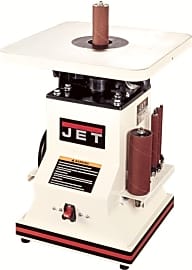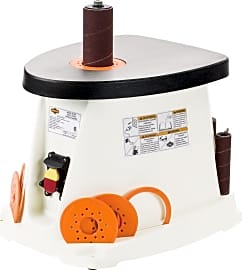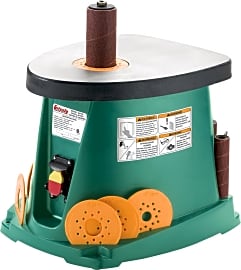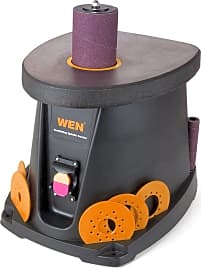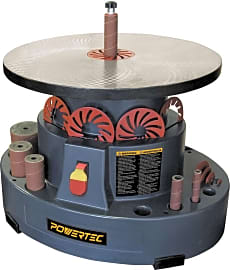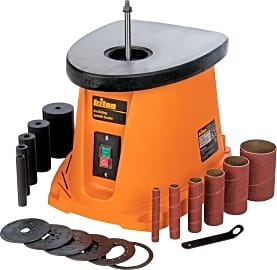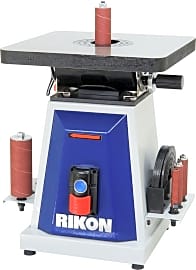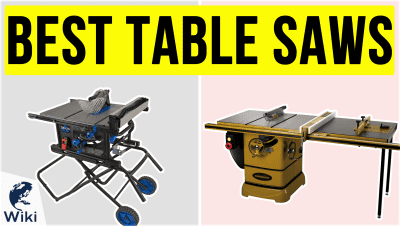The 10 Best Spindle Sanders

This wiki has been updated 38 times since it was first published in January of 2016. Whether creating curves or rounding off edges, you can rely on one of these spindle sanders for a reliable performance. Their oscillating action ensures that the abrasive will not wear down unevenly and that it produces a consistent scratch pattern along the length of the workpiece, resulting in the look of fine craftsmanship. When users buy our independently chosen editorial selections, we may earn commissions to help fund the Wiki.
Editor's Notes
December 27, 2019:
Added the Jet 723950, the Shop Fox W1686, and the Powertec OS1000.
The Jet and the Shop Fox were added to make sure that we were including excellent models of the free-standing type. Both of these machines include higher horsepower motors and larger spindles than table-top options. This makes it possible to sand large curved pieces that would be too big for the small spindles and tables of the bench-top models.
Many hobbyists will have no use for these large machines but would be quite satisfied with models like the Shop Fox W1831 and the Grizzly G0739, which offer good build-quality at a fraction of the price. Where possible, one should opt for models with heavy cast-iron or steel tables and induction motors. Spindle sanders are operated over long periods with minimal load - this makes induction motors ideal. DC motors - unless brushless - will need maintenance much more often.
Sanding creates fine wood particles that are hazardous if inhaled often. Always use breathing and eye protection to avoid health complications.
Smoothing Your Way To The Surface
In those situations, you're going to need a more specialized tool, like a spindle sander, to get the job done.
If you're familiar with woodworking and construction, then you've most likely been exposed to at least some type of sanding device used to help smooth out flat edges or polish flooring and walls. If you like to build furniture, then an orbital sander is probably among your arsenal of tools, as well. But what about sanding your individual pieces of wood that may be curved and not uniform in shape? For example, perhaps you'd like to build a circular frame for a painting or you fashion furniture with flowing designs that aren't boxy in shape like a cabinet? In those situations, you're going to need a more specialized tool, like a spindle sander, to get the job done.
A spindle sander is essentially a small-diameter rotating cylindrical drum covered with a gritted paper sleeve and supported on a work table. It is designed to achieve a smooth, flat finish on wood pieces that are characterized by curved edges. This device can also smooth the interior surfaces of deep hole cuts, which other sanders don't reach as easily. While the spindle sander thrives on its ability to rotate, the oscillating spindle sander takes this operation even further, with the ability of its spinning drum to move up and down along its axis as it rotates. This has several benefits, including the reduction of static friction, which would otherwise cause burning or band marks to appear on one's work pieces. It also extends the life of the machine's sanding sleeve by spreading its wear across a large surface area so that all the action doesn't occur in exactly the same place.
Spindle sanders each fall into one of three sizes that include stand-alone floor machines, bench-top models, and portable handheld units. Floor models are typically the largest, most durable, and expensive of the three options. They are used in professional capacities for completing large commercial jobs and are often equipped with electric motors up to one horsepower, making them ideal to accommodate large-diameter sanding sleeves and drum attachments.
Bench-top models are smaller units (that also feature motors) with bases built to support on-board storage for extra spindles, sleeves, drum plates, and table inserts. A bench-top model's sanding drum sits on top of a washer-like drum plate located in the middle of a table that ultimately supports the wood being sanded. Sanding sleeves then fit over the drum, while the unit's table insert rings slide down over both the machine's drum and sleeve components. This serves to eliminate any open space between the various sizes of drums and the table itself. The portable spindle sander closely resembles a conventional sanding device with the exception of its spindle attachment projecting outward from its bottom. You hold the flat surface of the portable tool against the flat surface of the wood being sanded, and the spindle runs along the curved outline of the work piece.
It's also helpful to note that a homeowner can convert an ordinary router or drill press into a spindle sander if they don't already have a device dedicated to do the job.
Spindle sanders offer several benefits. Firstly, they're ideal for smoothing out odd surfaces, arcs, contours and other unusual curves that conventional belt and orbital sanders cannot reach with their more traditional flat shapes. Secondly, they offer variety and versatility in their use of different sizes and diameters of abrasive drums to smooth out uniquely-shaped pieces of wood. Thirdly, and perhaps most importantly, they take up considerably less space than other types of floor-mounted devices, which comes in handy if your workshop has a lot of other bulky tools.
It's All About Form, Support, And Safety
When dealing with a large number of woodworking projects, the choice of tool really depends on several factors. These can include the types and shapes of the pieces you'll be sanding, what your customers are looking for in terms of their style, how much spindle storage you'll need for your intended applications, what your workshop environment is like (e.g. how much room you have), and how far you want to be able to stretch the sander's value. All this considered, one must decide which type of spindle sander will work best, be it a bench model or a floor-mounted device.
Don't forget that you're using a device with a powerful motor, abrasive spindles, and other heavy items.
For example, let's imagine that you have a successful furniture manufacturing business and that you specialize in building uniquely-shaped tables with rounded, curved legs and edges, each with its own individual accents and attractive detail. To get these shapes just the way you and your customers want them will require both mobility and efficiency in a sanding device. For that reason, a floor-mounted or tabletop oscillating spindle sander could be a great asset to your business. Its simple up-and-down motions and powerful motor work in tandem to give you the intricate detail you want, while minimizing extra wear and tear and preventing the need to replace parts or sanding sheets as often as you would have to with a more conventional device. This is not to say that furniture manufacturing is the only situation in which to use an oscillating spindle sander, but if you find that you or your employees need to do a lot of precision work with interior curves and sanded edges, such a device will only be an asset.
If you're thinking of investing in a tabletop spindle sander, ensuring the base is equipped with sturdy rubber feet will be an important consideration. The last thing you want is for your device to slip around when you're trying to smooth out the edges and curves of your work pieces.
When changing out your sanding drums often, it's important to make sure the device has at least some type of on-board storage capacity for the drums themselves, so the experience of switching them out remains seamless, and doesn't impact your level of productivity.
One must always be aware of important safety guidelines, regardless of the type of spindle sander you choose for your needs. Don't forget that you're using a device with a powerful motor, abrasive spindles, and other heavy items. Also, it's important to know how the machine works so that you're always informed and knowledgeable about your equipment. This can prevent turning a valuable asset like a spindle sander into a dangerous liability.
A Brief History Of Spindle Sanders
Sanding machines date as far back as the beginning of the 19th century. Patents for early sanders and polishers go back as far as 1818. These machines were stationary and utilized a drum or belt sanding mechanism, and they were mainly intended for professional use in workshops.
These machines were stationary and utilized a drum or belt sanding mechanism, and they were mainly intended for professional use in workshops.
Art Emmons, chief engineer at Porter-Cable, invented the first portable electric sander in 1927 called the Take-About Sander. This belt-driven device incorporated a vertically-mounted motor that controlled the belt by means of a worm-gear drive.
Inventor James McEwan patented the oscillating vertical spindle center in 1968. Today, there are sanders available in all shapes, sizes, and forms for handling a variety of finishing applications. So long as there are unique applications to be done with oddly-shaped objects, the popularity and need for the spindle sander will continue to grow, particularly as people and businesses choose to shape their surroundings with elaborately decorated wood designs.



